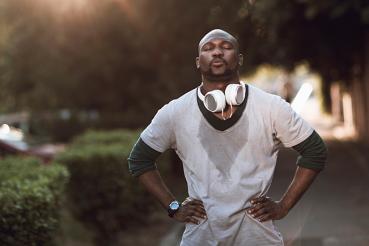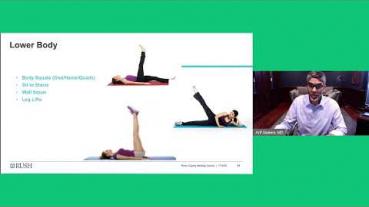The closure of most gyms at the beginning of the COVID-19 pandemic meant many of us were cut off from our favorite places to work out. While some people adapted their exercise routines to what can be done at home, many others hit pause on working out entirely.
Now that gyms are re-opening, it can be tempting to pack a bag and get some long overdue exercise. But rather than jumping back into your pre-COVID exercise routine and risking an injury, it’s important to ease back into working out.
We asked Jeremy Alland, MD, a sports medicine specialist at Rush who is one of the team doctors for the Chicago White Sox and Chicago Fire, for advice on going back to the gym safely.
Before you begin working out
Start by honestly assessing your present level of fitness to determine how much exercise your body is ready to take on.
If you were once lifting weights five days a week but haven’t been lifting more than a case of beer over the last few months, it’s best to initially scale back the number of days you work out — and insert rest days in-between. Even those who have been exercising throughout the pandemic will benefit from rest days.
“By putting in days of rest, we know that the muscles adapt to your training load and actually strengthen,” Alland explains.
Plan a varied routine to prevent overuse injuries
Once you’ve determined how many days to work out, it’s helpful to plan what you’ll be doing on each of those days before you actually go back into the gym.
Even if you’re not starting from scratch, varying your workouts from day to day to focus on different muscle groups is important. So if you’re doing cardio on day one, switch to strength training or core exercises the next day. This helps you avoid overloading muscle groups through overuse.
Overuse injuries go beyond the oddly pleasant soreness we experience after a productive workout. These injuries, which include stress fractures, shoulder impingement, shin splints and tendonitis, make it painful to do everyday tasks, forcing people to stop exercising until they’ve healed. In some cases, overuse injuries require treatment, like physical therapy.
“The tendency of the human mind is to find something you love and to do it as much as possible,” says Alland. “And it works out well to a certain extent because that's how we make gains. But at the same time, that's a good way to end up with overuse injuries. So when the floodgates open and you're allowed to go back to all the things you love to do, just try to have some variety.”
In addition to allowing the muscle groups to grow and recover properly so you don’t experience overuse injuries, cross-training can improve your performance. “It can actually make you better at your favorite sport or activity,” says Alland.
That’s because cross-training allows you to work more muscle groups and achieve a higher level of overall fitness. For example, a runner who does Pilates will see core strength improvements that contribute to better stability. And if you’ve only been doing strength training, adding an aerobic activity like swimming to your routine can help improve your endurance.
Varying your workouts from day to day ... helps you avoid overloading muscle groups through overuse.
While you’re exercising
Now that you have a plan, making a few more adjustments can help make you go back to the gym safely and successfully:
- Do a dynamic warm-up. Before hopping on the treadmill or bench press, prepare your body for the exercise ahead with a 15-20 minute dynamic workout that combines stretching with movement. Some examples include walking lunges or walking toe touches, which loosen up muscles and get blood flowing throughout the body.
- Start slowly. Even if you’ve been consistently weight training at home, but especially if you haven’t, it’s important to start with less weight and fewer repetitions/sets than when you left off. The same applies to cardio workouts: Start with shorter durations and lower intensity. Starting slower helps you avoid injuries and determine what’s comfortable, with the opportunity to gradually increase both intensity and frequency over a period of a few weeks.
- Cool down with static stretches. Perform static stretches — where you hold a stretch in one position for a period of time — after your workout. This type of stretch lengthens muscles during the recovery phase and enables longer-term increases in flexibility. “Doing static stretches before you exercise can actually hamper your performance,” Alland says. The reason: Lengthening your muscles reduces their ability to recoil and thus reduces the force they can exert.
Protecting yourself at the gym during COVID-19
Of course, a safe gym workout also includes taking steps to protect yourself from COVID-19.
Beyond wearing a mask, washing your hands and/or using hand sanitizer, and wiping down all equipment before and after use, it’s essential to avoid spending extended periods of time around other patrons. In other words, practicing social distancing. Going to the gym outside of peak hours could mean being around fewer people but is not always possible.
You can try rotating your location so you aren't in one area or around one person for more than 10-15 minutes at a time. Shorter workouts may also help achieve the same goal. And while the weather is nice, consider doing your cardio outdoors so you’re spending less time in a confined space.




